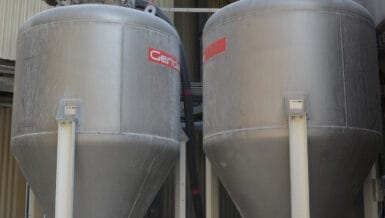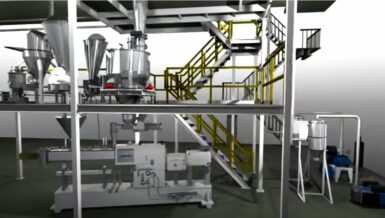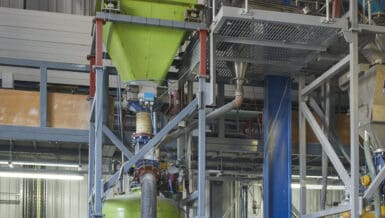While the company’s rye whiskey can spend six years barrel-aging, Dancing Goat needed only about five years to orchestrate three expansions. The most recent, which doubled the facility’s footprint to 34,000 sq ft (3,159 m2), moves grain nine-times faster using a Flexicon pneumatic conveying system.
Employing modern techniques
With each expansion, the company strives to preserve the traditional art and science of distillation as it adopts modern techniques. Thus, an old-school copper pot remains in service beside sleek distillation columns. At the cookers, where grains and malt are turned into a mash for fermentation, the company has twice upgraded its loading methods.
Originally, workers hoisted dozens of 50 lb (22.5 kg) bags of grain to load three 240 gal (908 L) cookers. When those were replaced by two 1,900 gal (7,192 L) cookers, Dancing Goat began receiving grain in bulk bags, unloading them into the vessels using a bulk bag discharger and flexible screw conveyor from Flexicon.

After its latest expansion added a third, 3,000 gal (11,356 L) cooker, Dancing Goat installed an 85 ft (26 m) long PNEUMATI-CON® pneumatic conveying system, also from Flexicon. The system transports the grains to two 7.5 cu ft (0.2 m3) hoppers, one feeding the two existing cookers and one feeding the new cooker. “The pneumatic system can load three times as much grain in one-third the time,” says Mike Reiber, director of operations. “Instead of driving fork trucks to the bulk bag discharger at the cookers and charging the cookers there, we created a grain-handling room and based our pneumatic conveying system there. It improves the process and is less painful for the operators.”
Weigh batching from a distance
Located on the opposite side of the facility from the cookers, the grain room houses the intake and terminus of the pneumatic circuit, and a bulk bag discharger mounted on load cells. With a forklift, workers load the bags into the discharger using a lifting frame that nests into receiving cups atop the discharger’s frame posts.
Once the bag spout is secured to a SPOUT-LOCK® clamp ring, the grains — milled to a flour-like consistency — flow into a 5.5 cu ft (155 L) floor hopper, from which a 5 ft (1.5 m) long flexible screw conveyor, inclined at 45 degrees, feeds the grain into the pneumatic conveying line via a pickup adapter, which includes an air inlet filter. Load cells supporting the discharger transmit loss-of-weight signals to a PLC that stops the screw conveyor once a pre-set batch weight has been fed into the pneumatic line.
The 5 in. (125 mm) diameter pneumatic line — under negative pressure generated by a 30 hp (23.3 kW) vacuum pump — transports the entire batch with no residual, across the facility to the two 7.5 cu ft (0.2 m3) capacity hoppers installed over the cookers. Inline fill/pass valves, located above each hopper, guide the grain to one hopper or the other, depending on the recipe.
The grain discharges into each cooker through a rotary valve. Above the twin cookers, a diverter valve controls whether the grain discharges from the hopper to the first or second cooker. The second hopper discharges to the third, larger cooker.

On the return side, the line runs from the hoppers back to the grain room to a 48 in. (122 cm) diameter filter-receiver whose cartridge filters separate the conveying air from carry-over grain dust. Reverse-pulse air nozzles dislodge accumulated material, which enters a 17 cu ft (0.5 m3) floor hopper with rotary valve that returns it to the conveying line feeding the cookers.
“That means I don’t have to worry about grain being aged at the bottom of my conveying line or about grain backing up in the filter-receiver,” Reiber says. “It also minimizes any concerns about attracting bugs or other pests and it gets the maximum amount of grain into the cookers.”
Pneumatic conveying: faster, cleaner, safer
The pneumatic conveying system — which can move as much as 14,000 lb (6,350 kg) per hour — reduces the time operators spend loading and discharging the bulk bags. “Instead of taking the bags to the use point, they’re now taken to the grain handling room near to where they’re stored,” Reiber says. “The forklifts travel maybe 50 ft (15.2 m) now, so the amount of handling, the forklift time, has been cut by 80 percent.”
Corn and rye, the grains Dancing Goat uses the most, flow from the bulk bags faster. “We were delivering a bag in roughly 15 minutes before. Now it’s in the 5-minute range for a bag of corn and 7 minutes for rye, with both bags weighing 1750 lb (794 kg),” Reiber says. A typical batch requires discharging six to eight bulk bags. “The operators who were here before we upgraded are amazed at how much less work and how fast the pneumatic system transfers the grain. We’re doing more with less work and in less time.” The operators are freed to perform other tasks in the distillery.
The operation is also cleaner and safer because the batching system is contained and operates under vacuum, preventing the grains from spreading dust. “We already make a flammable product, ethanol, and we don’t want to add potential fuel — airborne dust — to a zoned and classified space,” Reiber says.
Discharger promotes flow and evacuation
In the grain room, the bulk bag discharger contains dust and ensures reliable flow using several subsystems. At the bag spout interface a SPOUT-LOCK® clamp ring makes a dust-free connection to the floor hopper. As the bag empties, a TELE-TUBE® telescoping tube lowers the clamp ring, applying continual downward tension to keep the spout taut promoting flow. Meanwhile, FLOW-FLEXER® bag activator plates raise and lower the opposite bottom edges of the bag into a V shape, directing all of the grain out the spout.

“We use the bag activator plates every day on every grain. It helps break up the cube that can form during transport,” Reiber says. The company also relies on the discharger’s POWER-CINCHER® flow control valve, whose pneumatically driven bars close concentrically on the spout. “It’s a great tool when we need to restrict the flow or tie off a bag before it’s empty. It’s ideal for handling malt, which starts out blocky but then flows like water once it gets moving.”
In addition, the discharger’s posts can be raised or lowered to accommodate off-size bulk bags. “Our malt supplier’s bulk bags are about 14 inches longer than the normal ones,” Reiber notes. “But it only takes maybe five minutes to adjust all four posts.”
Non-stop advancement
While the distillery has become a destination for whiskey and spirits lovers, Reiber says the company is only partway into its journey, with plans to load the grains from bulk silos instead of bulk bags.
“We plan to tie in the silos to piggyback on the pneumatic conveying system,” Reiber says. “The goal is to cook, ferment, and distill around the clock, and this system has brought us much closer to doing that.”
Dancing Goat Distillery welcomes guests to explore the new grounds. To book a distillery experience, go to www.dancinggoat.com and follow @DancingGoatDistillery on social media for updates, events and new experiential offerings.












































